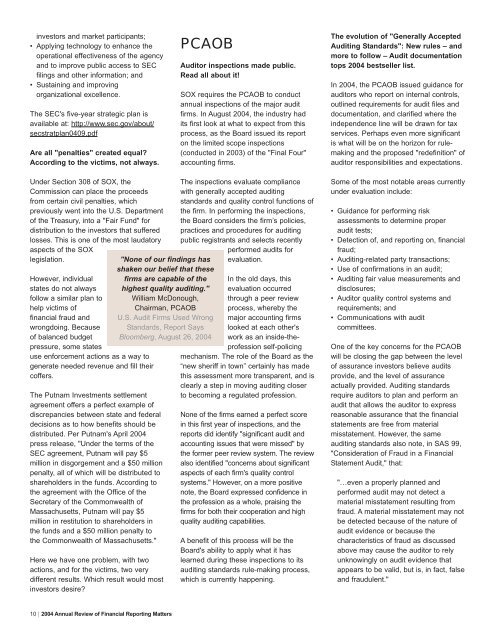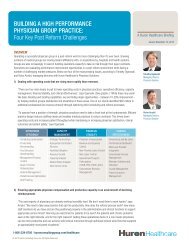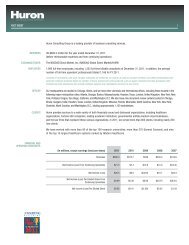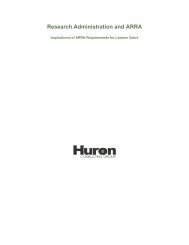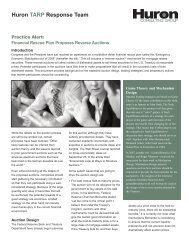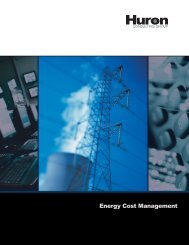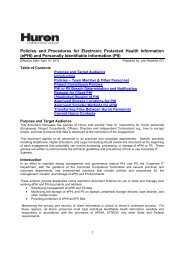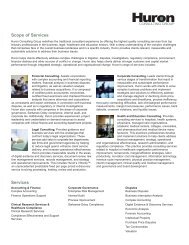2004 Annual Review of Financial Reporting Matters - Huron ...
2004 Annual Review of Financial Reporting Matters - Huron ...
2004 Annual Review of Financial Reporting Matters - Huron ...
You also want an ePaper? Increase the reach of your titles
YUMPU automatically turns print PDFs into web optimized ePapers that Google loves.
investors and market participants;<br />
• Applying technology to enhance the<br />
operational effectiveness <strong>of</strong> the agency<br />
and to improve public access to SEC<br />
filings and other information; and<br />
• Sustaining and improving<br />
organizational excellence.<br />
The SEC's five-year strategic plan is<br />
available at: http://www.sec.gov/about/<br />
secstratplan0409.pdf<br />
Are all "penalties" created equal<br />
According to the victims, not always.<br />
PCAOB<br />
Auditor inspections made public.<br />
Read all about it!<br />
SOX requires the PCAOB to conduct<br />
annual inspections <strong>of</strong> the major audit<br />
firms. In August <strong>2004</strong>, the industry had<br />
its first look at what to expect from this<br />
process, as the Board issued its report<br />
on the limited scope inspections<br />
(conducted in 2003) <strong>of</strong> the "Final Four"<br />
accounting firms.<br />
The evolution <strong>of</strong> "Generally Accepted<br />
Auditing Standards": New rules – and<br />
more to follow – Audit documentation<br />
tops <strong>2004</strong> bestseller list.<br />
In <strong>2004</strong>, the PCAOB issued guidance for<br />
auditors who report on internal controls,<br />
outlined requirements for audit files and<br />
documentation, and clarified where the<br />
independence line will be drawn for tax<br />
services. Perhaps even more significant<br />
is what will be on the horizon for rulemaking<br />
and the proposed "redefinition" <strong>of</strong><br />
auditor responsibilities and expectations.<br />
Under Section 308 <strong>of</strong> SOX, the<br />
Commission can place the proceeds<br />
from certain civil penalties, which<br />
previously went into the U.S. Department<br />
<strong>of</strong> the Treasury, into a "Fair Fund" for<br />
distribution to the investors that suffered<br />
losses. This is one <strong>of</strong> the most laudatory<br />
aspects <strong>of</strong> the SOX<br />
legislation.<br />
However, individual<br />
states do not always<br />
follow a similar plan to<br />
help victims <strong>of</strong><br />
financial fraud and<br />
wrongdoing. Because<br />
<strong>of</strong> balanced budget<br />
pressure, some states<br />
use enforcement actions as a way to<br />
generate needed revenue and fill their<br />
c<strong>of</strong>fers.<br />
The Putnam Investments settlement<br />
agreement <strong>of</strong>fers a perfect example <strong>of</strong><br />
discrepancies between state and federal<br />
decisions as to how benefits should be<br />
distributed. Per Putnam's April <strong>2004</strong><br />
press release, "Under the terms <strong>of</strong> the<br />
SEC agreement, Putnam will pay $5<br />
million in disgorgement and a $50 million<br />
penalty, all <strong>of</strong> which will be distributed to<br />
shareholders in the funds. According to<br />
the agreement with the Office <strong>of</strong> the<br />
Secretary <strong>of</strong> the Commonwealth <strong>of</strong><br />
Massachusetts, Putnam will pay $5<br />
million in restitution to shareholders in<br />
the funds and a $50 million penalty to<br />
the Commonwealth <strong>of</strong> Massachusetts."<br />
Here we have one problem, with two<br />
actions, and for the victims, two very<br />
different results. Which result would most<br />
investors desire<br />
"None <strong>of</strong> our findings has<br />
shaken our belief that these<br />
firms are capable <strong>of</strong> the<br />
highest quality auditing."<br />
William McDonough,<br />
Chairman, PCAOB<br />
U.S. Audit Firms Used Wrong<br />
Standards, Report Says<br />
Bloomberg, August 26, <strong>2004</strong><br />
The inspections evaluate compliance<br />
with generally accepted auditing<br />
standards and quality control functions <strong>of</strong><br />
the firm. In performing the inspections,<br />
the Board considers the firm’s policies,<br />
practices and procedures for auditing<br />
public registrants and selects recently<br />
performed audits for<br />
evaluation.<br />
In the old days, this<br />
evaluation occurred<br />
through a peer review<br />
process, whereby the<br />
major accounting firms<br />
looked at each other's<br />
work as an inside-thepr<strong>of</strong>ession<br />
self-policing<br />
mechanism. The role <strong>of</strong> the Board as the<br />
“new sheriff in town” certainly has made<br />
this assessment more transparent, and is<br />
clearly a step in moving auditing closer<br />
to becoming a regulated pr<strong>of</strong>ession.<br />
None <strong>of</strong> the firms earned a perfect score<br />
in this first year <strong>of</strong> inspections, and the<br />
reports did identify "significant audit and<br />
accounting issues that were missed" by<br />
the former peer review system. The review<br />
also identified "concerns about significant<br />
aspects <strong>of</strong> each firm's quality control<br />
systems." However, on a more positive<br />
note, the Board expressed confidence in<br />
the pr<strong>of</strong>ession as a whole, praising the<br />
firms for both their cooperation and high<br />
quality auditing capabilities.<br />
A benefit <strong>of</strong> this process will be the<br />
Board's ability to apply what it has<br />
learned during these inspections to its<br />
auditing standards rule-making process,<br />
which is currently happening.<br />
Some <strong>of</strong> the most notable areas currently<br />
under evaluation include:<br />
• Guidance for performing risk<br />
assessments to determine proper<br />
audit tests;<br />
• Detection <strong>of</strong>, and reporting on, financial<br />
fraud;<br />
• Auditing-related party transactions;<br />
• Use <strong>of</strong> confirmations in an audit;<br />
• Auditing fair value measurements and<br />
disclosures;<br />
• Auditor quality control systems and<br />
requirements; and<br />
• Communications with audit<br />
committees.<br />
One <strong>of</strong> the key concerns for the PCAOB<br />
will be closing the gap between the level<br />
<strong>of</strong> assurance investors believe audits<br />
provide, and the level <strong>of</strong> assurance<br />
actually provided. Auditing standards<br />
require auditors to plan and perform an<br />
audit that allows the auditor to express<br />
reasonable assurance that the financial<br />
statements are free from material<br />
misstatement. However, the same<br />
auditing standards also note, in SAS 99,<br />
"Consideration <strong>of</strong> Fraud in a <strong>Financial</strong><br />
Statement Audit," that:<br />
"…even a properly planned and<br />
performed audit may not detect a<br />
material misstatement resulting from<br />
fraud. A material misstatement may not<br />
be detected because <strong>of</strong> the nature <strong>of</strong><br />
audit evidence or because the<br />
characteristics <strong>of</strong> fraud as discussed<br />
above may cause the auditor to rely<br />
unknowingly on audit evidence that<br />
appears to be valid, but is, in fact, false<br />
and fraudulent."<br />
10 | <strong>2004</strong> <strong>Annual</strong> <strong>Review</strong> <strong>of</strong> <strong>Financial</strong> <strong>Reporting</strong> <strong>Matters</strong>


